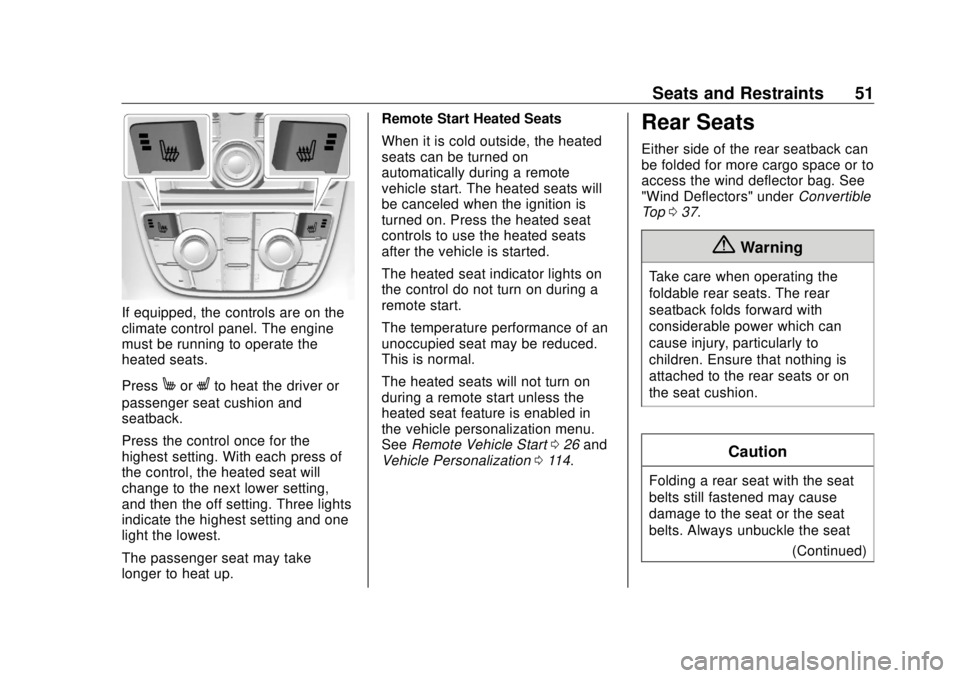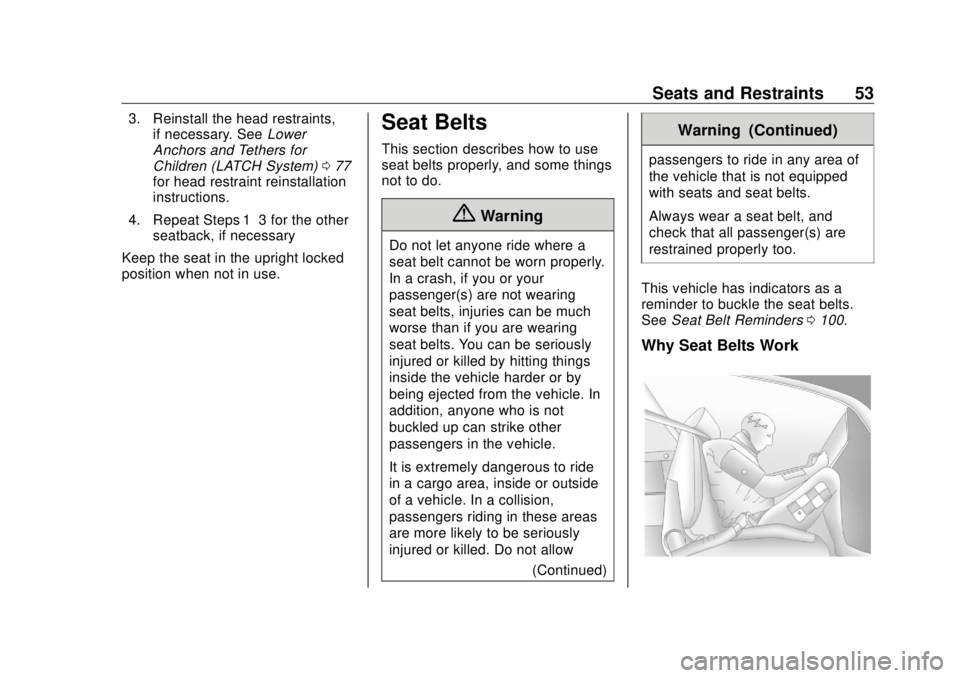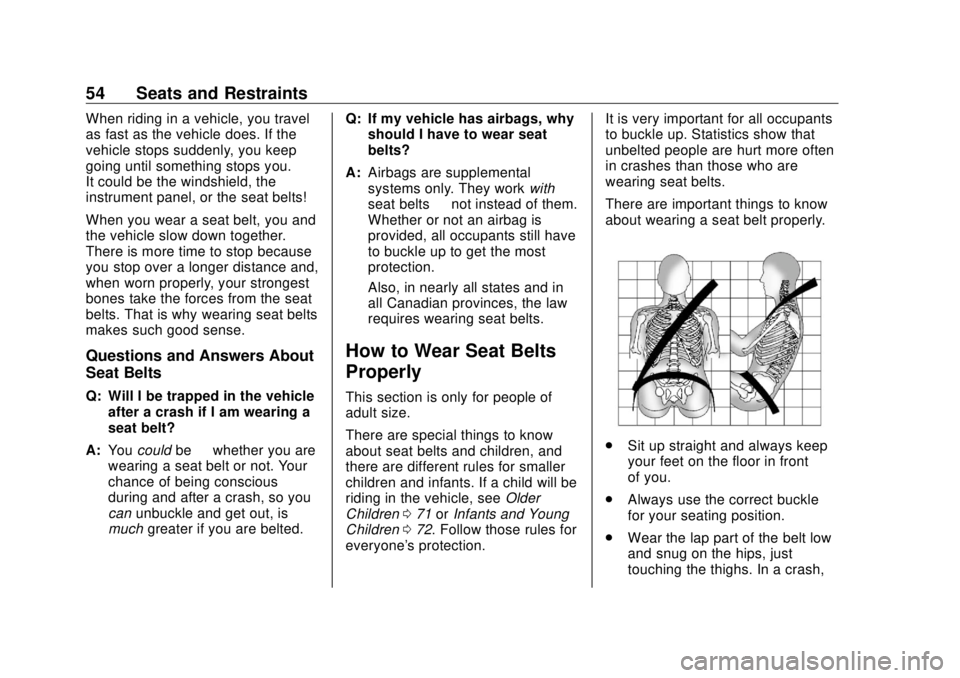2018 BUICK CASCADA child restraint
[x] Cancel search: child restraintPage 4 of 303

Buick Cascada Owner Manual (GMNA-Localizing-U.S-11373983) - 2018 -
CRC - 7/10/17
Introduction 3
Danger, Warning, and
Caution Warning messages found on vehicle
labels and in this manual describe
hazards and what to do to avoid or
reduce them.
{ DangerDanger indicates a hazard with a
high level of risk which will result
in serious injury or death.
{ WarningWarning indicates a hazard that
could result in injury or death.
Caution
Caution indicates a hazard that
could result in property or vehicle
damage. A circle with a slash through it is a
safety symbol which means “ Do
Not, ” “ Do not do this, ” or “ Do not let
this happen. ”
Symbols The vehicle has components and
labels that use symbols instead of
text. Symbols are shown along with
the text describing the operation or
information relating to a specific
component, control, message,
gauge, or indicator.
M : Shown when the owner ’ s
manual has additional instructions
or information.
* : Shown when the service
manual has additional instructions
or information.
0 : Shown when there is more
information on another page —
“ see page. ” Vehicle Symbol Chart
Here are some additional symbols
that may be found on the vehicle
and what they mean. See the
features in this manual for
information.
9 : Airbag Readiness Light
# : Air Conditioning
! : Antilock Brake System (ABS)
$ : Brake System Warning Light
" : Charging System
I : Cruise Control
` : Do Not Puncture
^ : Do Not Service
B : Engine Coolant Temperature
O : Exterior Lamps
_ : Flame/Fire Prohibited
. : Fuel Gauge
+ : Fuses
3 : Headlamp High/Low-Beam
Changer
j : LATCH System Child Restraints
* : Malfunction Indicator Lamp
Page 13 of 303

Buick Cascada Owner Manual (GMNA-Localizing-U.S-11373983) - 2018 -
CRC - 7/10/17
12 In Brief See Heated Front Seats 0 50 .
Head Restraint
Adjustment Do not drive until the head restraints
for all occupants are installed and
adjusted properly.
To achieve a comfortable seating
position, change the seatback
recline angle as little as necessary
while keeping the seat and the head
restraint height in the proper
position.
See Head Restraints 0 47 and
Reclining Seatbacks 0 49 . Seat Belts
Refer to the following sections for
important information on how to use
seat belts properly:
.
Seat Belts 0 53 .
.
How to Wear Seat Belts Properly
0 54 .
.
Lap-Shoulder Belt 0 55 .
.
Lower Anchors and Tethers for
Children (LATCH System) 0 77 .Passenger Sensing
System
The passenger sensing system
turns off the front outboard
passenger frontal airbag and knee
airbag under certain conditions. No
other airbag is affected by the
passenger sensing system. See
Passenger Sensing System 0 65 for
important information.
The passenger airbag status
indicator will be visible on the center
stack when the vehicle is started.
See Passenger Airbag Status
Indicator 0 101 .
Page 47 of 303

Buick Cascada Owner Manual (GMNA-Localizing-U.S-11373983) - 2018 -
CRC - 7/10/17
46 Seats and Restraints
Seats and
Restraints Head Restraints Head Restraints . . . . . . . . . . . . . . . 47
Front Seats Power Seat Adjustment . . . . . . . . 48
Lumbar Adjustment . . . . . . . . . . . . 49
Reclining Seatbacks . . . . . . . . . . . 49
Seatback Latches . . . . . . . . . . . . . . 50
Heated Front Seats . . . . . . . . . . . . 50
Rear Seats Rear Seats . . . . . . . . . . . . . . . . . . . . 51
Seat Belts Seat Belts . . . . . . . . . . . . . . . . . . . . . 53
How to Wear Seat Belts
Properly . . . . . . . . . . . . . . . . . . . . . . 54
Lap-Shoulder Belt . . . . . . . . . . . . . 55
Seat Belt Use During
Pregnancy . . . . . . . . . . . . . . . . . . . . 57
Seat Belt Extender . . . . . . . . . . . . . 58
Safety System Check . . . . . . . . . . 58
Seat Belt Care . . . . . . . . . . . . . . . . . 58
Replacing Seat Belt System
Parts after a Crash . . . . . . . . . . . 59 Airbag System Airbag System . . . . . . . . . . . . . . . . . 59
Where Are the Airbags? . . . . . . . 61
When Should an Airbag
Inflate? . . . . . . . . . . . . . . . . . . . . . . . 62
What Makes an Airbag
Inflate? . . . . . . . . . . . . . . . . . . . . . . . 63
How Does an Airbag
Restrain? . . . . . . . . . . . . . . . . . . . . . 63
What Will You See after an
Airbag Inflates? . . . . . . . . . . . . . . 63
Roll Bars . . . . . . . . . . . . . . . . . . . . . . . 64
Passenger Sensing System . . . 65
Servicing the Airbag-Equipped
Vehicle . . . . . . . . . . . . . . . . . . . . . . . 69
Adding Equipment to the
Airbag-Equipped Vehicle . . . . . 69
Airbag System Check . . . . . . . . . . 70
Replacing Airbag System Parts
after a Crash . . . . . . . . . . . . . . . . . 70
Child Restraints Older Children . . . . . . . . . . . . . . . . . 71
Infants and Young Children . . . . 72
Child Restraint Systems . . . . . . . 75
Where to Put the Restraint . . . . . 76
Lower Anchors and Tethers for
Children (LATCH System) . . . . 77
Replacing LATCH System Parts
After a Crash . . . . . . . . . . . . . . . . . 84 Securing Child Restraints (With
the Seat Belt in the
Rear Seat) . . . . . . . . . . . . . . . . . . . 85
Securing Child Restraints (With
the Seat Belt in the
Front Seat) . . . . . . . . . . . . . . . . . . . 87
Page 49 of 303

Buick Cascada Owner Manual (GMNA-Localizing-U.S-11373983) - 2018 -
CRC - 7/10/17
48 Seats and Restraints Active Head Restraints Your vehicle has an Active Head
Restraint System in the front
outboard seating positions. These
automatically activate to reduce the
risk of neck injury if the vehicle is hit
from behind.
{ WarningIf your head restraint has been
activated due to a rear collision,
you must return the vehicle to the
dealer for inspection and
re-setting or replacement of the
system. Rear Seats The vehicle ’ s rear seats have
non-adjustable head restraints in the
outboard seating positions.
The rear head restraints are
designed to be removed. See
“ Head Restraint Removal and
Reinstallation ” under Lower Anchors
and Tethers for Children (LATCH
System) 0 77 .
If you are installing a child restraint
in the rear seat, see “ Securing a
Child Restraint Designed for the
LATCH System ” under Lower
Anchors and Tethers for Children
(LATCH System) 0 77 .Front Seats Power Seat Adjustment Power Driver Seat Adjustment
To adjust a power driver seat,
if equipped:
.
Move the seat forward or
rearward by sliding the control
forward or rearward.
.
Raise or lower the front part of
the seat cushion by moving the
front of the control up or down.
Page 52 of 303

Buick Cascada Owner Manual (GMNA-Localizing-U.S-11373983) - 2018 -
CRC - 7/10/17
Seats and Restraints 51
If equipped, the controls are on the
climate control panel. The engine
must be running to operate the
heated seats.
Press
M or
L to heat the driver or
passenger seat cushion and
seatback.
Press the control once for the
highest setting. With each press of
the control, the heated seat will
change to the next lower setting,
and then the off setting. Three lights
indicate the highest setting and one
light the lowest.
The passenger seat may take
longer to heat up. Remote Start Heated Seats
When it is cold outside, the heated
seats can be turned on
automatically during a remote
vehicle start. The heated seats will
be canceled when the ignition is
turned on. Press the heated seat
controls to use the heated seats
after the vehicle is started.
The heated seat indicator lights on
the control do not turn on during a
remote start.
The temperature performance of an
unoccupied seat may be reduced.
This is normal.
The heated seats will not turn on
during a remote start unless the
heated seat feature is enabled in
the vehicle personalization menu.
See Remote Vehicle Start 0 26 and
Vehicle Personalization 0 114 .Rear Seats Either side of the rear seatback can
be folded for more cargo space or to
access the wind deflector bag. See
"Wind Deflectors" under Convertible
Top 0 37 .
{ WarningTake care when operating the
foldable rear seats. The rear
seatback folds forward with
considerable power which can
cause injury, particularly to
children. Ensure that nothing is
attached to the rear seats or on
the seat cushion.
Caution
Folding a rear seat with the seat
belts still fastened may cause
damage to the seat or the seat
belts. Always unbuckle the seat
(Continued)
Page 53 of 303

Buick Cascada Owner Manual (GMNA-Localizing-U.S-11373983) - 2018 -
CRC - 7/10/17
52 Seats and Restraints Caution (Continued)belts and return them to their
normal stowed position before
folding a rear seat.
To fold the rear seatbacks:
1. Remove the wind deflector if
installed.
2. Move the front seats forward or
remove the rear head
restraints.
See Power Seat Adjustment
0 48 or Lower Anchors and
Tethers for Children (LATCH
System) 0 77 for head restraint
removal instructions. Store the
head restraints in the
cargo area. 3. Pull the release switch in the
trunk to fold the rear
seatback down.
4. Fold the seatback forward.
5. Repeat Steps 1 – 4 for the other
seatback, if necessary.
To raise the seatback:
{ Warning
A seat belt that is improperly
routed, not properly attached,
or twisted will not provide the
protection needed in a crash. The
(Continued) Warning (Continued) person wearing the belt could be
seriously injured. After raising the
rear seatback, always check to be
sure that the seat belts are
properly routed and attached, and
are not twisted.
1. Lift the seatback up and push it
rearward until it latches into
place. Keep the seat belts clear
of the seatback and untwisted.
{ WarningIf the seatback is not locked, it
could move forward in a sudden
stop or crash. That could cause
injury to the person sitting there.
Always pull forward on the top of
the seatback at the area of the
latch to be sure it is locked.
2. Push and pull on the seatback
to make sure it is locked into
position.
Page 54 of 303

Buick Cascada Owner Manual (GMNA-Localizing-U.S-11373983) - 2018 -
CRC - 7/10/17
Seats and Restraints 533. Reinstall the head restraints,
if necessary. See Lower
Anchors and Tethers for
Children (LATCH System) 0 77
for head restraint reinstallation
instructions.
4. Repeat Steps 1 – 3 for the other
seatback, if necessary
Keep the seat in the upright locked
position when not in use.
Seat Belts This section describes how to use
seat belts properly, and some things
not to do.
{ WarningDo not let anyone ride where a
seat belt cannot be worn properly.
In a crash, if you or your
passenger(s) are not wearing
seat belts, injuries can be much
worse than if you are wearing
seat belts. You can be seriously
injured or killed by hitting things
inside the vehicle harder or by
being ejected from the vehicle. In
addition, anyone who is not
buckled up can strike other
passengers in the vehicle.
It is extremely dangerous to ride
in a cargo area, inside or outside
of a vehicle. In a collision,
passengers riding in these areas
are more likely to be seriously
injured or killed. Do not allow
(Continued) Warning (Continued) passengers to ride in any area of
the vehicle that is not equipped
with seats and seat belts.
Always wear a seat belt, and
check that all passenger(s) are
restrained properly too.
This vehicle has indicators as a
reminder to buckle the seat belts.
See Seat Belt Reminders 0 100 .
Why Seat Belts Work
Page 55 of 303

Buick Cascada Owner Manual (GMNA-Localizing-U.S-11373983) - 2018 -
CRC - 7/10/17
54 Seats and Restraints When riding in a vehicle, you travel
as fast as the vehicle does. If the
vehicle stops suddenly, you keep
going until something stops you.
It could be the windshield, the
instrument panel, or the seat belts!
When you wear a seat belt, you and
the vehicle slow down together.
There is more time to stop because
you stop over a longer distance and,
when worn properly, your strongest
bones take the forces from the seat
belts. That is why wearing seat belts
makes such good sense.
Questions and Answers About
Seat Belts Q: Will I be trapped in the vehicle
after a crash if I am wearing a
seat belt?
A: You could be — whether you are
wearing a seat belt or not. Your
chance of being conscious
during and after a crash, so you
can unbuckle and get out, is
much greater if you are belted. Q: If my vehicle has airbags, why
should I have to wear seat
belts?
A: Airbags are supplemental
systems only. They work with
seat belts — not instead of them.
Whether or not an airbag is
provided, all occupants still have
to buckle up to get the most
protection.
Also, in nearly all states and in
all Canadian provinces, the law
requires wearing seat belts.
How to Wear Seat Belts
Properly This section is only for people of
adult size.
There are special things to know
about seat belts and children, and
there are different rules for smaller
children and infants. If a child will be
riding in the vehicle, see Older
Children 0 71 or Infants and Young
Children 0 72 . Follow those rules for
everyone's protection. It is very important for all occupants
to buckle up. Statistics show that
unbelted people are hurt more often
in crashes than those who are
wearing seat belts.
There are important things to know
about wearing a seat belt properly.
.
Sit up straight and always keep
your feet on the floor in front
of you.
.
Always use the correct buckle
for your seating position.
.
Wear the lap part of the belt low
and snug on the hips, just
touching the thighs. In a crash,